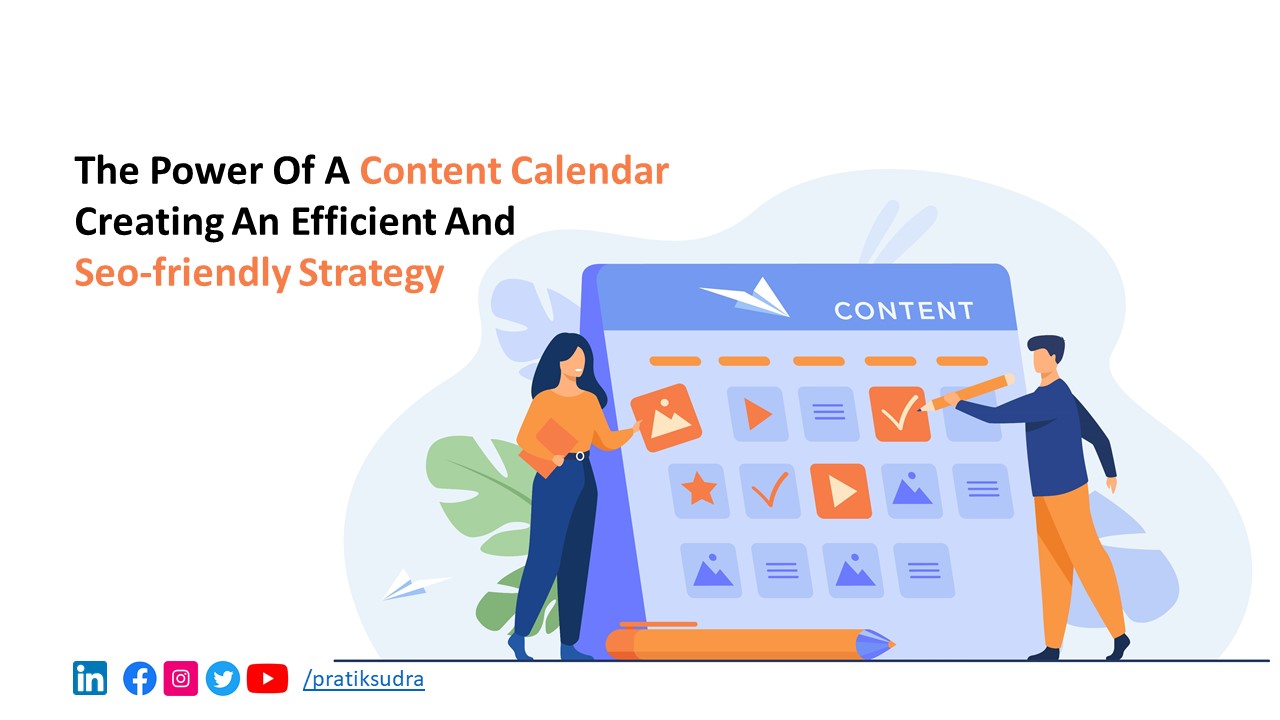Synopsis:
A content calendar is a powerful tool for planning, organizing, and optimizing your content strategy. This blog emphasizes the significance of a content calendar in achieving strategic planning, maintaining consistency, streamlining collaboration, and optimizing content for search engines. By creating an efficient and SEO-friendly content calendar, businesses can effectively engage their target audience, enhance brand visibility, and drive organic traffic. The blog provides actionable tips for creating a content calendar, including setting clear objectives, conducting keyword research, planning content types and formats, establishing a publishing schedule, and tracking performance. By leveraging the power of a content calendar, businesses can stay ahead in the competitive content marketing landscape and achieve their goals with precision and efficiency.
Table Of Content
- Introduction
- SThe Importance of a Content Calendar:
- Strategic Planning
- Consistency and Time Management:
- Streamlined Collaboration
- SEO Optimization:
- Efficiently Creating a Content Calendar:
- Set Clear Objectives
- Understand Your Target Audience
- Conduct Keyword Research
- Plan Content Types and Formats:
- Establish a Publishing Schedule
- Assign Roles and Responsibilities:
- Track and Analyze Performance:
- Example: Content Calendar Strategy for "Tasty Bites" Cloud Kitchen
- SThe Importance of a Content Calendar:
- Conclusion
Introduction
In the fast-paced world of content marketing, staying organized and strategic is key to success. A content calendar is an indispensable tool for businesses and marketers to plan, create, and distribute content effectively. In this blog post, we will explore the importance of a content calendar, its role in SEO optimization, and provide valuable tips on creating an efficient and SEO-friendly content calendar.
The Importance of a Content Calendar:
-
Strategic Planning:
A content calendar allows you to plan your content in advance, ensuring a well-structured and cohesive content strategy. It enables you to align your content with business goals, target audience preferences, and upcoming events or holidays, maximizing its impact. -
Consistency and Time Management:
By organizing your content in a calendar format, you can establish a consistent publishing schedule. Consistency builds trust with your audience, enhances brand reputation, and boosts SEO efforts. Additionally, a content calendar helps manage your time efficiently, ensuring deadlines are met and content creation remains on track. -
Streamlined Collaboration:
Content creation often involves a team effort. A content calendar serves as a centralized platform for collaboration, allowing team members to coordinate tasks, assign responsibilities, and maintain clear communication. This ensures everyone is on the same page and contributes to a unified content strategy. -
SEO Optimization:
A well-planned content calendar enables you to integrate SEO strategies seamlessly. By conducting keyword research and incorporating high-ranking keywords into your content calendar, you can optimize your content for search engines. This enhances visibility, drives organic traffic, and increases the chances of ranking higher in search engine results.
Efficiently Creating a Content Calendar:
-
Set Clear Objectives:
Define your content marketing goals and align them with your business objectives. This will guide your content creation and distribution strategy. -
Understand Your Target Audience:
Research and analyze your target audience's preferences, interests, and pain points. This insight helps you create valuable and engaging content that resonates with your audience. -
Conduct Keyword Research:
Utilize SEO tools like Google Keyword Planner, SEMrush, or Ahrefs to identify relevant and high-ranking keywords in your industry. Incorporate these keywords strategically into your content calendar to optimize your content for search engines. -
Plan Content Types and Formats:
Consider a mix of content types such as blog posts, videos, infographics, podcasts, and social media posts. Diversifying your content formats helps cater to different audience preferences and maximizes engagement. -
Establish a Publishing Schedule:
Determine how often you will publish content and create a schedule that aligns with your resources and audience expectations. Be consistent and maintain a regular publishing cadence. -
Assign Roles and Responsibilities:
Clearly define roles and responsibilities within your content team. Assign tasks, deadlines, and ensure smooth collaboration and accountability. -
Track and Analyze Performance:
Measure the performance of your content using analytics tools like Google Analytics or social media insights. This data provides valuable insights into content effectiveness and helps you refine your future content calendar.
Example: Content Calendar Strategy for "Tasty Bites" Cloud Kitchen
"Tasty Bites" is a cloud kitchen that specializes in healthy and flavorful meals. They aim to attract health-conscious individuals and busy professionals who seek convenient yet nutritious food options. To effectively plan and execute their content strategy, "Tasty Bites" implements a content calendar strategy. Here's how they utilize their content calendar to achieve their goals:
-
Establishing Objectives:
"Tasty Bites" sets clear objectives for their content strategy. These include increasing brand awareness, driving website traffic, and promoting their weekly specials and seasonal menus. -
Identifying Target Audience:
They conduct market research to understand their target audience better. They identify health-conscious individuals, busy professionals, and fitness enthusiasts as their primary target audience. -
Keyword Research and SEO Optimization:
Using keyword research tools like SEMrush and Google Keyword Planner, "Tasty Bites" identifies relevant keywords related to healthy eating, meal prep, and local food delivery. They incorporate these keywords strategically into their content calendar to optimize their website and blog posts for search engines. -
Planning Content Types and Formats:
"Tasty Bites" plans a mix of content types to cater to their audience's preferences. Their content calendar includes blog posts, recipe videos, social media posts with enticing food photography, and informative infographics on healthy eating tips. -
Creating a Publishing Schedule:
They establish a consistent publishing schedule based on their resources and audience engagement. For example, they publish two blog posts per week, release a recipe video every Friday, and share social media posts daily. -
Assigning Roles and Responsibilities:
"Tasty Bites" assigns roles and responsibilities within their content team. They have a content manager responsible for overall strategy, a writer for blog posts, a videographer for recipe videos, and a social media manager for social media content. Each team member has clear tasks and deadlines. -
Collaborating and Reviewing:
They use project management tools like Trello to collaborate effectively. Each content piece has a card assigned to it, which includes details, deadlines, and comments for team members to provide feedback and track progress. -
Tracking and Analyzing Performance:
"Tasty Bites" uses Google Analytics to monitor website traffic, user engagement, and conversions. They regularly review the analytics data to assess the performance of their content and make data-driven decisions for future content planning.
By implementing a content calendar strategy, "Tasty Bites" efficiently plans, creates, and distributes content aligned with their objectives. Their content calendar helps them maintain consistency, optimize content for SEO, engage their target audience, and promote their offerings effectively. With a well-executed content strategy, "Tasty Bites" enhances their brand visibility, attracts more customers, and establishes themselves as a go-to cloud kitchen for healthy and delicious meals.
Conclusion:
In conclusion, the power of a content calendar cannot be overstated when it comes to creating an efficient and SEO-friendly content strategy. By implementing a well-structured content calendar, businesses can effectively plan, create, and distribute content, leading to a host of benefits.


